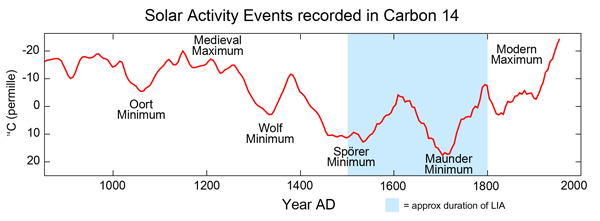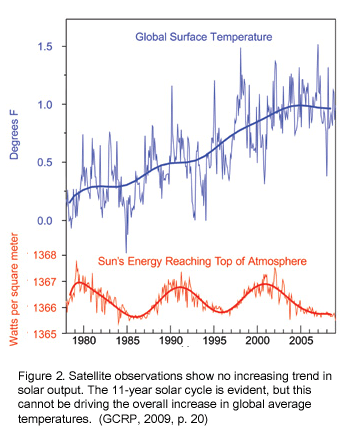The Little Ice Age: Skeptics skating on thin ice
Posted on 9 September 2010 by gpwayne
Climate change skeptics suggest that because the climate has changed dramatically in the past – and without man’s intervention – it is possible that current changes to the Earth’s climate are also a natural event. You may be familiar with paintings depicting Londoners skating on the frozen River Thames, when winters, at least in the northern hemisphere, were more severe. The beginning and end of this period are subject to various interpretations, but the period is referred to as the Little Ice Age (LIA) and occurred between the 16th to 19th centuries.
Limited History
If we are to understand the LIA, we need to figure out what caused it. Scientists have examined several important strands of evidence about the LIA, including the activity of the sun, of volcanoes, and ocean heat circulation, principle drivers of natural climate change.
The activity of the sun can be assessed by looking at proxies – processes we know are affected by the sun’s activity. One of these is the formation of the radioactive isotope Carbon-14 in the atmosphere, which plants then absorb. By measuring carbon-14 in tree rings and other materials we know are from a certain period, we can estimate how active the sun was at the time. This graph shows the sun’s activity over the last millennium:

The carbon-14 data used in this graph go up to 1950. The graph below gives a fuller picture, showing that in the last three decades, the sun's normal cycle of activity has remained steady, while temperatures have shot up:

Yet while the dips in solar activity correlate well with the LIA, there are other factors that, in combination, may have contributed to the climate change:
- Volcanic activity was high during this period of history, and we know from modern studies of volcanism that eruptions can have strong cooling effects on the climate for several years after an eruption.
- The ‘ocean conveyor belt’ – thermohaline circulation – might have been slowed down by the introduction of large amounts of fresh water e.g. from the Greenland ice cap, the melting by the previous warm period (the Medieval Warm Period).
- Sudden population decreased caused by the Black Death may have resulted in a decrease of agriculture and reforestation of agricultural land.
Can We Draw a Conclusion?
In truth, not really. The Little Ice Age remains for the present the subject of speculation. The most likely influence during this period is variable output from the sun combined with pronounced volcanic activity. We know that from the end of the LIA to the 1950s the sun’s output increased. But since WW2 the sun has slowly grown quieter, yet the temperature on Earth has gone up.
The skeptical argument that current warming is a continuation of the same warming that ended the LIA is unlikely. There is a lack of evidence for a suitable forcing (e.g. the sun) and numerous correlations with known natural forcings that can account for the LIA itself, and the subsequent climate recovery. Taken in isolation, the LIA might cast doubt on the theory of climate change. Considered alongside the empirical evidence, model predictions and a century of scientific research into the climate, recovery from the LIA is not a plausible theory to explain the observed evidence and rate of global climate change.
This post is the Basic version (written by Graham Wayne) of the skeptic argument "We're coming out of an ice age".































 Arguments
Arguments























 0
0  0
0






Comments